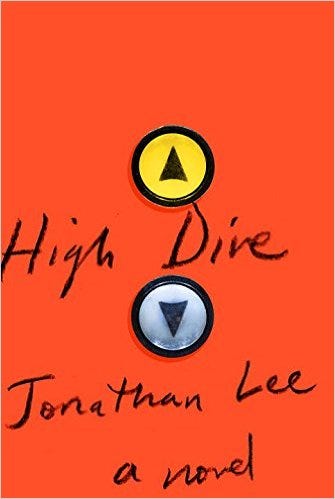Reading Lists
10 Great Teens In Contemporary Fiction: A Reading List

by Jonathan Lee

One of the three central characters in High Dive (Knopf, 2016), my novel about the bombing of an English seaside hotel in 1984, is a seventeen-year-old girl named Freya. She sits behind the hotel reception desk. She watches guests. She gets very bored. She’s a noticer — a useful character for a writer to employ. She sees all the little daily routines that the bomb is destined to disrupt, the personal moments that will soon flee the scene.

As I was writing Freya’s sections of High Dive, I took breaks to read a lot of other novels and stories that featured the perspectives of teenagers. Some of these are listed below. What unites this reading list, I think, is that the authors have accomplished one of the most difficult feats in fiction — rendering a teenager in all of his or her chaotic, needy, conflicted glory. Each writer below captures how in adolescent life the longing for individuality rubs up against the desperate desire to fit in. So often teenagers in fiction are reduced to type: the mean girl at school; the all-star jock; the prom queen; the lonely chess club kid. What’s interesting to me about the fictions below is that they do the opposite. They show how incorporating a teenage perspective into a story can provide an element of in-betweenness — a productive, unsettling complexity. Those trapped between youth and adulthood can see in both directions at once. They know something about departures and arrivals. They are not yet fully formed, therefore they stretch in more directions. Their lives are more crowded with question marks.
1. Susan from “Static,” by Susan Steinberg, a story collected in Hydroplane
The teenager seems caught between a desire to emulate these women and a desire to erase them entirely.
“Static,” like all of Susan Steinberg’s work, is difficult to categorize. It seems to tread the line between fiction and memoir in its content, and the line between poetry and prose in its form. In this story the narrator (also named Susan) is beginning to discover, on a family vacation, the power her teenage beauty gives her over boys. Steinberg balances wonderfully the girl’s awareness of her own desirability with her unease at the influence girl-like women have over her father. Every summer sees him falling under the spell of “a new bleach-blonde with toothpick legs.” The teenager seems caught between a desire to emulate these women and a desire to erase them entirely.
2. Magnus in The Accidental, by Ali Smith
Seventeen-year-old Magnus is the quiet heart of this mordant novel about family life in England. He withdraws further and further from his family after joining a school prank with a photograph — one that led to a classmate’s suicide: “They took her head. They fixed it on the other body. Then they sent it round everybody’s e-mail. Then she killed herself.” An equally great achievement is Astrid, Magnus’s sister, a 12 year-old teetering on the brink of teen life whose favorite word is “substandard.” Smith’s close third person narration is elastic enough to take us deep inside the minds of these adolescents while keeping, at other times, an ironic distance from their self-obsession.
3. Fran in “The Summer People,” by Kelly Link, a story collected in Get In Trouble
Link’s O. Henry Prize winning story follows Fran, a teenage girl in rural North Carolina. Her mother isn’t around at all and her father leaves her, for long stretches of time, tending to the homes of the “summer people” who vacation on their land. Fran has the flu at the start of the story and continues to get sicker. Something of the quality of a fever-dream starts to soak through the narrative. The summer people seem to represent the adults all children are indebted to, and Fran’s fairytale struggle, comic and disturbing by turns, seems to see her aspire to her own form of human ownership. “When you do things for them,” she says of the summer people, “they’re beholden to you.”
4. Chris in The Finishing School, by Muriel Spark
Spark’s last novel, published in 2004, is less well known than The Prime of Miss Jean Brodie, her other fable about youthful education, but it achieves equally unsettling insights. A lot of fiction focuses on the powerlessness of teenagers, but here Spark looks at teenage self-centeredness and how it might provide the perfect conditions for making art. She offers the reader a group of confident 17-year-olds from rich European families, including a princess of somewhere no one can name. The most memorable of all is a teenager named Chris, a precocious young novelist whose doubt-free pursuit of his fiction drives his teacher, another wannabe writer, utterly insane.
5. Hattie in The Twelve Tribes of Hattie, by Ayana Mathis
It’s the perfect form for a book that explores the moments when obedience to the past comes into conflict with the desire to write a new future.
It’s 1923 and fifteen-year-old Hattie Shepherd, moved by the Great Migration, leaves Georgia and heads north. She wants a better life in Philadelphia, but a difficult teenage marriage and the quick demands of motherhood leave her hardened rather than happy. The novel’s structure allows us into Hattie’s youth before opening us up to the hopes and disappointments of her children. It’s the perfect form for a book that explores the moments when obedience to the past comes into conflict with the desire to write a new future.
6. Helen in “Honored Guest,” by Joy Williams, a story collected in Honored Guest
In this story Helen, an 11th grader, watches her mother Lenore battling a terminal illness. At first the drama of the fight seems to add a certain sheen of excitement to family life, but the beauty of the story lies in its portrayal of a mother and daughter who need one another so badly that each begins to turn away from the other before detachment is forced upon them. Williams is so good at exploring the teenager’s search for authenticity — for anything that feels real. Helen contemplates suicide but worries it’s too “corny.” Two of her classmates killed themselves the previous year. “They had left notes everywhere and they were full of misspellings and pretensions. Theirs had been a false show.”
7. Alivopro in The Hopeful, by Tracy O’Neill
…the obsessiveness, the longing for recognition, and the conflict inherent in trying to establish one’s particular sense of self while seeking applause from everyone else.
A figure skating prodigy, sixteen-year old Alivopro Doyle is one of a few “hopefuls” trying, through the grace of her immature body, to skate her way into the Olympics. Ali’s ascendancy is soon interrupted by a fall — she fractures two vertebrae — and O’Neill, across two interlocking timeframes, beautifully traces her depreciating freedom of movement and of thought. The Hopeful is, among other things, a great literary exploration of adolescence: the obsessiveness, the longing for recognition, and the conflict inherent in trying to establish one’s particular sense of self while seeking applause from everyone else. “I was sixteen,” the narrator thinks, “and I was maybe getting too old.”
8. Kafka in Kafka on the Shore, by Haruki Murakami
Might this be Murakami’s best book? One half of the narrative concerns a man named Nakata who has an uncanny ability to communicate with cats. The other chapters are devoted to Kafka, a 15-year-old running away from his father’s house to escape an Oedipal curse. “Taking crazy things seriously is a serious waste of time,” we’re told in a Holden Caulfield-like aside, and Murakami’s gift is to train a wry comic eye on the everyday concerns of teenage life while also taking seriously — and capturing on the page — a teenager’s fantastical dreams.
9. Addy in Dare Me, by Megan Abbott
This novel was recommended by two friends in 2013, but it took a while for me to be convinced that I’d enjoy a book about a high-school cheerleading squad. It turns out Abbott’s plot is desperately addictive, her exploration of the betrayals and misplaced trust of teenage years is deep and nuanced, and the writing is so sharp it could cut your throat. 16-year-old Addy Hanlon is a superb creation, caught in a moment of limbo all adolescents might recognize, “like a thing arrested between coming and going. Like the second before a crouch becomes a bound.”
10. The unnamed narrator in Grotesque, by Natsuo Kirino
Imagine Heathers set in Japan and rewritten by Claire Messud.
Sophie Harrison, reviewing Kirino’s literary thriller in The New York Times in 2007, wrote that ‘“Grotesque is full of schoolgirls in long socks but blanchingly free of cuteness, a combination we might call Uh-Oh Kitty.” The narrator suffers in her teen years because she’s “half,” as she puts it — one parent is Japanese and the other is Swiss — and because she doesn’t have the easy beauty of her sister. The confessional energy of the book derives almost entirely from the eloquent hatred the narrator feels for everything: her home, her sister, the elite school they’ve been sent to. It’s compelling stuff. Imagine Heathers set in Japan and rewritten by Claire Messud.
You can find Jonathan Lee & High Dive on tour this March and April, visiting New York, Chicago, Iowa City, Portland, San Francisco, Los Angeles, and New Orleans.









